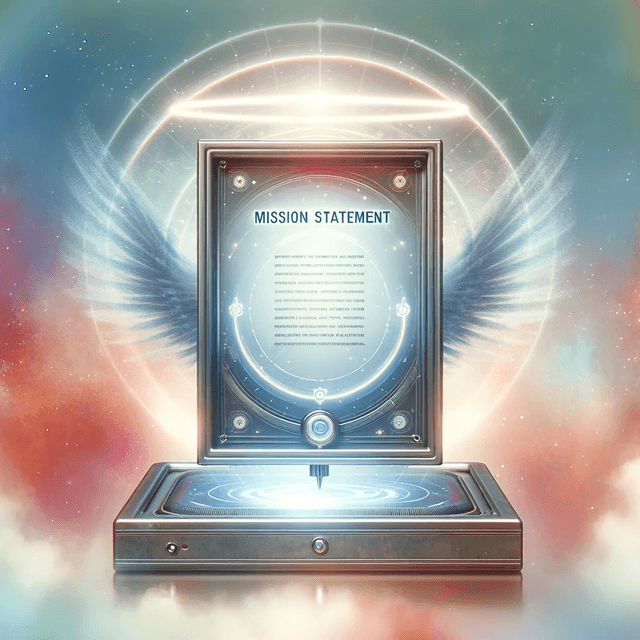
Mission Statement Generator
Craft a mission statement that encapsulates your organization's essence and propels it towards its vision.
Instructions
- Describe your company name, industry, goal, ethos, audience, etc.
- Press "Generate" and Typli will write a mission statement for you.
Details
Crafting Meaningful Purpose: A Deep Dive into Good Mission Statements
In the bustling ecosystem of business methodology, the mission statement stands as a lighthouse – guiding organizations through stormy markets and keeping them anchored to their core values. Far from being just words on a page, a good mission statement captures the essence of an organization’s goals, strategies, and beliefs. It is the heart from which the body of the organization operates, influencing everything from decision-making processes to workplace culture. In this article, we aim to dissect the anatomy of effective mission statements, showcase exemplars from various sectors, and provide actionable advice for crafting statements that resonate deeply with employees, stakeholders, and the world at large.
A solid mission statement is transformative, influencing not just the trajectory of the company but also how it is perceived by the outside world. As we delve into the nuances of what makes a mission statement truly effective, we invite our readers to look beyond the surface and explore how these declarations can become the driving force behind organizational success.
Let's embark on this journey to explore the world of compelling mission statements, learn from those who’ve mastered the art, and gather insights to craft or refine our own.
Table of Contents
Key Takeaways
-
A mission statement is a succinct description of an organization’s purpose, guiding its strategies, operations, and decision-making processes.
-
It differs from a vision statement and values, focusing on the organization’s current identity and approach to achieving goals.
-
Effective mission statements are clear, concise, inspirational, and aligned with the organization’s core values and objectives.
-
Crafting a powerful mission statement involves reflecting on the organization's core, engaging stakeholders, focusing on unique strengths, and being open to evolving the statement as necessary.
-
Common pitfalls in crafting mission statements include vague language, unrealistic claims, and overly broad statements.
-
Examining mission statements from leading organizations like Google, WWF, and Nike can provide valuable insights into crafting impactful declarations.
-
The elements of a strong mission statement include clarity in communication, brevity for memorability, inspiration to motivate action, and alignment with the organization’s core values.
-
Implementing the mission statement requires wide and frequent communication, incorporation into strategic decision-making, and cultivating a culture that reflects the statement’s values.
-
The evolution of mission statements is natural as organizations grow and markets change. Regular review and thoughtful revision can renew organizational direction and commitment.
-
Ultimately, a well-crafted mission statement serves as the cornerstone of an organization, inspiring and uniting employees, stakeholders, and the broader community toward a common purpose.
Understanding Mission Statements
At its core, a mission statement succinctly describes the purpose of an organization. It serves as a compass, guiding the company’s strategies, operations, and decision-making processes. More than just words, it is a declaration of the organization's raison d'être—why it exists and what it seeks to achieve. Distinct from a vision statement, which paints a picture of the company's future aspirations, and values, which outline the principles and beliefs that guide actions, the mission statement focuses on the present—defining the organization’s identity and its approach to reaching its goals.
Mission statements consist of key components that crystallize into a potent narrative. These include:
-
Purpose : Clarifying why the organization exists.
-
Values : Highlighting the guiding principles.
-
Strategy : Outlining the approach to achieving its objectives.
-
Standards and Behaviors : Setting expectations for how goals will be achieved.
The impact of a mission statement extends far beyond its initial creation. It molds the organization's culture, informs strategic planning, and fosters a sense of community and direction among employees. Given its significance, the crafting or revising of a mission statement is a monumental task, one that requires thoughtful consideration, inclusive dialogue, and a deep understanding of the organization’s essence.
Crafting a Powerful Mission Statement
Creating a compelling mission statement is both an art and a science. It demands a balance between conciseness and expressiveness, between generality and specificity. Here are some tips to guide the process:
-
Reflect on your organization’s core : What are its fundamental goals? What problems does it seek to solve? What is its biggest contribution to the world?
-
Engage stakeholders : Include employees, customers, and other key stakeholders in the crafting process to ensure the statement resonates with all involved.
-
Be succinct yet impactful : Aim for clarity and brevity. A powerful mission statement is easy to remember and repeat.
-
Focus on unique strengths : Highlight what sets your organization apart from the competition.
-
Evolve as necessary : Be open to revising your mission statement as your organization grows and changes.
Avoid common pitfalls such as vague jargon, overambitious claims that can't be realistically achieved, or creating a statement that is too broad to be meaningful. A mission statement should inspire and motivate, not confuse or mislead.
Examples of Effective Mission Statements
Analyzing mission statements from leading organizations can provide valuable insights into what makes them resonate. For instance:
-
Technology Sector : Google's mission is "to organize the world's information and make it universally accessible and useful." This simple yet profound statement reflects the company’s expansive vision and its commitment to user-centricity.
-
Non-Profit Sector : The World Wildlife Fund (WWF) operates under the mission "to conserve nature and reduce the most pressing threats to the diversity of life on Earth." This is a clear call to action that encompasses the organization’s goals and values.
-
Retail Sector : Nike’s mission is "to bring inspiration and innovation to every athlete in the world." This inclusive statement extends its reach beyond just professional athletes, aligning with its broad customer base.
These examples stand out due to their clarity, inclusivity, and the inspiration they provide. They are crisp, memorable, and align closely with the organization's strategic goals and values.
For more insights, Harvard Business Review offers a comprehensive guide on crafting effective mission statements, showcasing examples across sectors.
Breaking Down the Elements of a Strong Mission Statement
Let’s dissect the attributes that contribute to the efficacy of a mission statement:
-
Clarity : An effective mission statement is easy to understand, avoiding overly complex language or industry jargon. It communicates its purpose in a straightforward manner, making it accessible to a broad audience.
-
Brevity : The power of a mission statement often lies in its conciseness. Keeping it short ensures it is memorable and easily communicated across the organization and beyond.
-
Inspiration : It should stir emotions and motivate action, aligning with the aspirational aspects of the organization's work. An inspiring mission statement galvanizes employees, aligning their efforts towards a common goal.
-
Alignment : The statement should embody the organization's core values and objectives, ensuring consistency in actions and decisions across the entity. It serves as a touchstone for aligning strategy, operations, and culture.
Implementing Your Mission Statement
Once a powerful mission statement is crafted, the next step is embedding it into the DNA of the organization:
-
Communicate widely and often : Ensure every employee understands the mission statement and can see how their role contributes to it.
-
Incorporate into operational strategy : Use the mission statement as a guide for strategic decisions, ensuring that initiatives align with the organization’s core purpose.
-
Cultivate a culture around the mission : Foster behaviors and attitudes that reflect the values and goals outlined in the mission statement.
Successful implementation means the mission statement is not just words on a wall but a living, breathing aspect of the organization's everyday operations and culture.
The Evolution of Mission Statements
As organizations grow and markets change, revisiting and potentially revising the mission statement can become necessary. It’s a process that should be approached with care, preserving the core essence of the organization while allowing for evolution in response to internal developments and external demands. Such revisions can reinvigorate a company's direction and renew its commitment to its foundational goals.
Conclusion
A well-crafted mission statement is a cornerstone of organizational identity and strategy. It encapsulates the purposes, dreams, and values of an entity into a declaration of intent and direction. Through our exploration of effective examples and best practices, it's clear that a meaningful mission statement has the power to inspire, guide, and unite.
We leave you armed with knowledge and encouragement, urging you to reflect on the mission that drives your work. Whether crafting a new statement or refining an existing one, the goal remains the same: to crystallize your organization’s heart and soul into words that resonate, motivate, and endure.
FAQs
How often should a mission statement be revised?
Revise as necessary, but consider a review every three to five years or during major organizational changes.
Can a small business or startup benefit from a mission statement?
Absolutely. A clear mission can guide decisions, attract the right talent, and communicate value to customers.
How to involve employees in the mission statement process?
Conduct surveys, workshops, or brainstorming sessions to gather input and engage employees in the mission's development.
What are the signs of a weak or ineffective mission statement?
Lack of clarity, inability to differentiate the organization, and failure to inspire action are signs the mission statement may need a revisit.
Additional Resources
For those seeking to expand their knowledge and tools in crafting or refining their mission statements, here are a couple of highly recommended reads:
Equipped with this guide, your journey toward crafting an effective mission statement that encapsulates your organization's essence and propels it towards its vision is well underway. Remember, the power of a mission statement lies not only in the words themselves but in the actions they inspire within your organization and beyond.
Try more AI writing tools
There's 186 to choose from.

Chat with PDF
Chat with your PDF documents using AI to extract insights and answer questions.

AI Estimate Generator
Quickly generate accurate estimates for projects, services, or products with Typli.ai's AI Estimate Generator. Streamline your budgeting process with precision.

AI Contract Generator
Create comprehensive and professional contracts with the help of AI.

AI Business Plan Generator
Create comprehensive and professional business plans with the help of AI.

AI Proposal Generator
Create comprehensive and professional proposals with the help of AI.

AI Business Description Generator
Create compelling and professional business descriptions with the help of AI.

AI Event Name Generator
Generate unique and captivating names for your events with the help of AI.

AI Press Release Generator
Create professional and engaging press releases with the help of AI.

Review Generator
Boost your business with authentic reviews using a review generator and enhance your online reputation effortlessly.

Business Name Generator
Find the perfect name for your business. Get creative and unique name ideas instantly.

Restaurant Name Generator
Create a memorable name for your restaurant. Get creative and unique name ideas tailored to your cuisine and concept.

Elevator Pitch Generator
Craft a compelling elevator pitch in seconds. Perfect for startups, entrepreneurs, and professionals seeking to make a strong impression.

Product Name Generator
Create a captivating name for your product. Get creative and unique name ideas that resonate with your target audience.

App Name Generator
Create a catchy name for your mobile app. Get creative and unique name ideas that stand out in the app store.

About Us Generator
Create a compelling About Us page for your website. Share your story, values, and mission with your audience effectively.

Testimonial Generator
Easily create authentic testimonials with our cutting-edge AI testimonial generator.

Vision Statement Generator
Craft a powerful vision statement that defines your organization's future aspirations with Typli's Vision Statement Generator.

Mission Statement Generator
Craft a mission statement that encapsulates your organization's essence and propels it towards its vision.

Coffee Shop Name Generator
Create a warm and inviting name for your coffee shop. Get creative and unique name ideas that reflect the cozy atmosphere of your café.

Business Idea Generator
Need a business idea? Let Typli’s Free AI Business Idea Generator spark your creativity and find the perfect concept for you.

Brand Name Generator
Say goodbye to naming roadblocks and hello to the perfect brand name - Typli’s AI Brand Name Generator makes it easy and fast.

AI Brand Voice Generator
Define and refine your brand’s unique voice with Typli's Free AI Brand Voice Generator. Whether you're creating a new brand identity or strengthening your existing one, this tool helps you develop a consistent and compelling brand voice.

AI Business Jargon Generator
Generate industry-specific business jargon with Typli's Free AI Business Jargon Generator. Perfect for crafting corporate communications, presentations, or adding a professional touch to your documents.

Clickbait Title Generator
Generate attention-grabbing headlines with Typli's Free Clickbait Title Generator. Whether you're writing for blogs, social media, or ads, this tool helps you create compelling titles that drive clicks and engagement.

AI Table Chart Generator
Generate custom HTML/JS code for tables and charts with Typli's Free AI Table Chart Generator. Perfect for creating visual data representations for your website or reports.

Sales Pitch Generator
Craft compelling and persuasive sales pitches with Typli.ai’s AI Sales Pitch Generator. Perfect for sales professionals, entrepreneurs, and marketers to deliver impactful messages that drive results.

News Article Generator
Generate well-researched and engaging news articles with Typli.ai’s AI News Article Generator. Perfect for journalists, bloggers, and content creators looking to quickly draft high-quality news content.

Product Description Generator
Let our AI product description generator do the heavy lifting so you can focus on growing your business and increasing sales.

Bakery Name Generator
Create a sweet and memorable name for your bakery. Get creative and unique name ideas that will make your bakery stand out.

AI Slogan Generator
Get ahead of the competition with our AI slogan generator, making it easy to craft memorable brand slogans.

Brewery Name Generator
Create a unique and memorable name for your brewery. Get creative name ideas that capture the essence of your craft beer.